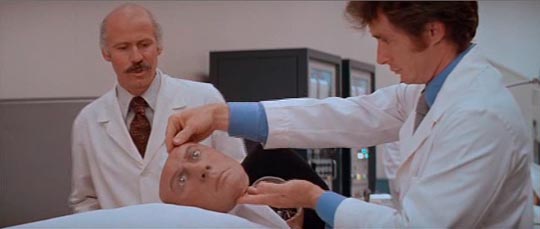
One of the things I like to do here at nouspique is pay homage to instances of extraordinary prescience. One such instance came forty years ago from the late Michael Crichton with his film, Westworld. Two guys (James Brolin and Richard Benjamin) take a fantasy vacation at a resort where the worlds of the old west, ancient Rome, and medieval Europe are recreated in exacting detail. Guests interact with lifelike robots who do everything from fight to fuck, but always it’s understood that the guests come away unscathed and the robots disappear at night for servicing by a small army of technicians. But when one of the guests is bitten by a mechanical snake and suffers a real injury, we sense that not everything is quite right in paradise. The resort’s lead scientists meet to discuss the problem of escalating incidents and we have the following conversation:
Scientist #1: Despite our corrections the breakdown rate continued to climb. Then medieval world began to have trouble. Now we’re seeing more western world breakdowns. There’s a clear pattern here which suggests an analogy to an infectious disease process spreading from one resort area to the next.
Scientist #2: Perhaps there are superficial similarities to disease.
Scientist #3: It’s only a theoretical concept. There are many ways to order that data.
Scientist #4: I must confess I find it difficult to believe in a disease of machinery.
Scientist #1: But we aren’t dealing with ordinary machines here. These are highly complicated pieces of equipment, almost as complicated as living organisms.
I don’t know if this is the moment when the idea of the computer virus entered into popular culture. But it must be close. For decades, science fiction had been full of mad robot stories, but I’m unaware of any stories that explained the madness by suggesting a virus in the robot’s programming. Isaac Asimov’s I Robot stories came close, but not quite. His robots went mad because of logical conflicts produced by his three laws of robotics. His robots couldn’t cope with ethical quandaries.
In Westworld, the scientists decide to do nothing: let the machines fail and then assess the problem. Big mistake. The latest model, played by Yul Brynner, is just a little too smart for the scientists, and before you can say hubris, all the scientists have suffocated in their hermetically sealed labs. The Yul Brynner robot shoots James Brolin in the gut, at which point Richard Benjamin and his awesome stache high-tail it outta there.
The year before Westworld came out, Crichton published The Terminal Man, a similar cautionary tale about our overconfidence in science to mediate the relationship between humans and machines. The Terminal Man tells the story of Harry Benson who consents to a brain implant which allows electrodes to stimulate specific centres in his brain. Benson suffers from severe epilepsy and, during blackout periods, runs around doing horrible things which he can’t remember. Scientists assure him that the implant will sort everything out. Naturally, it all goes to shit.
The Terminal Man is what I’d describe as a “Pandora’s Box” kind of tale: technology unleashes a power that it can’t control. Westworld is more of a Bible story. Into a paradisaical world slithers a mechanical snake and pretty soon the satanic robot is tormenting people for the fruits of their knowledge.
There’s only one thing Crichton didn’t anticipate. In Westworld, the virus appeared spontaneously. It was the unexpected consequence of extraordinary complexity. In our world, even the complex machines are as dumb as ever. The viruses come from humans and whatever damage they wreak upon the world is directly attributable to human malevolence. In a way, that’s reassuring. In our world, at least we know who to blame.